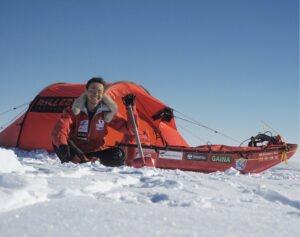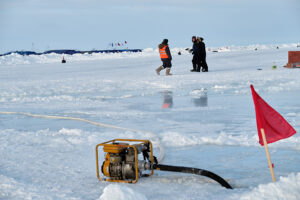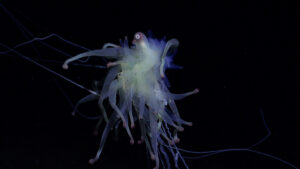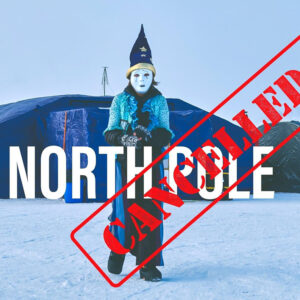The Antarctic: Ten Years of the “Library in the Ice” Celebrating the anniversary of an art project that offers one of the most extraordinary collections of books in the world
Bremerhaven. Germany’s southernmost library can be found at 70°40´S, 08°16´W and has endured in one of our planet’s most inhospitable regions for ten years now. In the 2004/2005 summer in the southern hemisphere, the Cologne-based artist Lutz Fritsch erected the “Library in the Ice” on the Antarctic Ekström Ice Shelf – to create a space for interaction between science and culture in the far reaches of the “white continent”. Ever since, the library container and its collection of books have been fixtures at the Neumayer Station, a research station operated by the Alfred Wegener Institute, Helmholtz Centre for Polar and Marine Research (AWI). However, the artist and the residents of the Neumayer III Station are the only ones who know which books the library holds – and that’s how it’s meant to stay.
The cherry-wood bookshelves inside the green, insulated cargo container currently hold roughly 700 books. Every year, they are joined by new novels, non-fiction works, coffee-table books and biographies – each of which was donated by an established or up-and-coming German artist, author, musician or scientist. In personal dedications written in each book, they explain what moved them to share the specific book with those who have to brave the winter at the Antarctic research station.
When it comes to which books fill the shelves, and who donated them, only the scientists and technicians at the station, and of course Lutz Fritsch, know. The artist and initiator of the “Library in the Ice” personally writes to every sponsor, asking them to donate a book. “Every book is a very personal gift to those staying at the research station through the winter. That’s also why part of the idea behind the ‘Library in the Ice’ is to keep both the identities of the gift-giver and the books they select a secret. As a result, for those of us on the outside, the library remains something fictional, but for the scientists at the station it is very real, and home to a very special collection of books specifically chosen for the unique place they live and work,” explains Lutz Fritsch.
From concept to reality
The idea of creating a “Library in the Ice” came to Lutz Fritsch during his first expedition to the Antarctic in the summer season 1994/1995. He was the first German artist to travel to the Alfred Wegener Institute’s previous Neumayer Station on board the research icebreaker Polarstern. The laboratories and living quarters of the old station – the second Neumayer Station – were completely covered by ice. “That’s why I wanted to create a sheltered space on the surface of the ice, where the residents of the research station could look out on the expanse of the Ice Shelf. I wanted to give them a chance to find calm and inspiration, to contemplate nature, civilisation, science and culture,” relates the artist.
Ten years later the time had come: In early 2005 Lutz Fritsch embarked on his second trek to the Antarctic, this time to launch his art project “Library in the Ice”. The Alfred Wegener Institute supplied the insulated cargo container that would house the library and transported it to the Antarctic.
Thanks to the financial support of private sponsors, the artist had already furnished the container with bookshelves, lighting, a table and leather sofa in Cologne, and painted the outer walls in spring green, emerald green, yellow-green and leaf green, the roof and floor in red. “It took me a long time to decide on the right colour for the library, until I realised that it could only be green. You simply can’t find green anywhere in the Antarctic: The ice is normally white, sometimes grey and sometimes blue; the polar researchers’ snowsuits are red. So green seemed to be the colour that those staying for the winter would most long to see,” explains Lutz Fritsch.
The library in everyday life
Since its arrival, the green container has become a fixed element of the research station. A case in point: The Station Director of every overwintering team automatically also becomes the new librarian. And when the Neumayer III Station was opened in 2009, the “Library in the Ice” was moved to the station’s new location. Though the current station is no longer located under the ice, there is still a 100-metre path between it and the library. “The overwintering researchers should make a conscious choice to journey from science to culture,” says Lutz Fritsch.
For some of the station’s residents the “Library in the Ice” has above all become a sanctuary – like it did for Holger Schmithüsen. The climate researcher from the Alfred Wegener Institute spent the winter of 2010 at the Neumayer III Station. “For me the library was like a small outpost, a quiet zone, so to speak. Of course you also have enough peace and quiet at the station in winter, but the library is a unique place, separate from the daily grind,” recalls Holger Schmithüsen.
The Alfred Wegener Institute conducts research in the Arctic, Antarctic and in the high and mid-latitude oceans. The Institute coordinates German polar research and provides important infrastructure such as the research icebreaker Polarstern and research stations in the Arctic and Antarctic to the national and international scientific world. The Alfred Wegener Institute is one of the 18 research centres of the Helmholtz Association, the largest scientific organisation in Germany.
Lutz Fritsch is noted for his large location-specific sculpture “Rhine Orange” (1992) where the Ruhr River flows into the Rhine in Duisburg, the “Library in the Ice” (2005) in the Antarctic, and his two-piece sculpture “Centre of Town” (2008), located at the beginning and end of the autobahn between Cologne and Bonn. Fritsch has examined the relation between line, colour, plane and space since 1978. His artistic work is chiefly characterised by his simultaneously intuitive and analytical approach to these aspects, which he has explored in various media, from sculptures to sketches and photography. Fritsch was born in 1955 in Cologne, where he currently resides. He studied at the Düsseldorf Art Academy’s Münster Extension.
www.lutz-fritsch.de | www.bibliothek-im-eis.de






